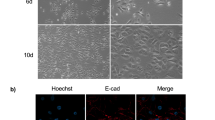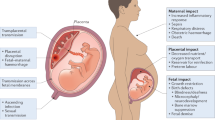Abstract
The effect of trypsinization of human amnion membranes on the susceptibility of amnion cells toChlamydia trachomatis TW-3 infection was examined by infectivity titrations using standard procedures of chlamydial inoculation, and detection of chlamydial inclusions. Epithelial cells derived from freshly trypsinized membranes as well as primary and secondary cultured cells that were freshly removed from monolayers by trypsin treatment were not susceptible to infection at 30 min and at 2 and 6 h after trypsinization. Monolayers grown 18 h and up to 5 or more days after trypsinization were susceptible to infection. Primary 5-day monolayers derived from each of nine placentas inoculated with chlamydiae showed a range of titers from 10−3 to 10−6.5 (SD=1.2 logarithm). Primary monolayers supported the multiplication of chlamydiae to consistently higher titers than secondary and tertiary monolayers from the same amnion.
Similar content being viewed by others
Literature Cited
Allan, I., Pearce, J. H. 1979. Modulation by centrifugation of cell susceptibility to chlamydial infection. Journal of General Microbiology111:87–92.
Beeuwkes, H. 1960. Cytochemistry and sensitivity of a human amnion cell line to Coxsackie A24 (ECHO 9) virus. Antonie van Leeuwenhoek Journal of Microbiology and Serology26:331–339.
Bernkopf, H., Mashiah, P. 1962. The growth cycle of trachoma in FL cell cultures. Journal of Immunology88:570–571.
Byrne, G. I. 1978. Kinetics of phagocytosis ofChlamydia psittaci by mouse fibroblasts (L cells): Separation of the attachment and ingestion stages. Infection and Immunity19:607–612.
Byrne, G. I., Moulder, J. W. 1978. Parasite-specified phagocytosis ofChlamydia psittaci andChlamydia trachomatis by L and HeLa cells. Infection and Immunity19:598–606.
Croy, T. R., Kus, C. C., Wang, S. P. 1975. Comparative susceptibility of eleven mammalian cell lines to infection with trachoma organisms. Journal of Clinical Microbiology1:434–439.
Evans, R. T., Taylor-Robinson, D. 1979. Comparison of various McCoy cell treatment procedures used for detection ofChlamydia trachomatis. Journal of Clinical Microbiology10:198–201.
Gottschalk, A., Belyavin, G., Biddle, F. 1972. In: Gottschalk A. (ed.), Glycoproteins: Their composition, structure and function, 2nd ed., part B, p. 1082. Amsterdam, Elsevier.
Grayston, J. T., Wang, S., Woollridge, D. L., Yang, Y., Johnston, P. B. 1960. Trachoma studies of etiology, laboratory diagnosis and prevention. Journal of the American Medical Association172:1577–1586.
Harrison, H. R., Riggin, R. T. 1979. Infection of untreated primary human amnion monolayers withChlamydia trachomatis. Journal of Infectious Diseases140:968–1971.
Hayfflick, L. 1977. The cellular basis for biological aging, pp. 159–186. In: Finch, C. E., Hayflick, L. (eds.), Handbook of the biology of aging. Van Nostrad, Rhinehold Co., New York.
Hodges, G. M., Livingston, D. C., Franks, L. M. 1973. The localization of trypsin in cultured mammalian cells. Journal of Cell Science12:887–902.
Holland, J. I. 1961. Receptor affinities as major determinants of enterovirus tissue tropisms in humans. Virology15:312–326.
Kordová, N., Wilt, J. C. 1980. Primary human amnion cells for studies ofChlamydia trachomatis. Current Microbiology3:259–262.
Kuo, C. C., Wang, S. P., Grayston, J. T. 1973. Effect of polycations, polyamnions, and neuraminidase on the infectivity of trachoma-inclusion conjuctivitis and lymphogranuloma-venereum organisms in HeLa cells: Sialic acid residues as possible receptors for trachoma-inclusion conjunctivitis. Infection and Immunity8:74–79.
Levy, N. J. 1979. Wheat germ agglutinin blockage of chlamydial attachment sites: Antagonism byN-acetyl-d-glucosamine. Infection and Immunity25:946–953.
Meager, A., Hughes, R. C. 1977. Virus receptors, pp. 143–195. In: Cuatrecsas, P., Graeves, M. F. (eds.): Receptors and recognition, series A, vol 4. London: Chapman and Hall.
McLaren, L., Holland, J. J., Syverton, J. T. 1960. The mammalian cell-virus relationship. V. Susceptibility and resistance of cells in vitro to infection by Coxsackie A9 virus. Journal of Experimental Medicine112:581–594.
Pontén, J. 1976. The relationship between in vitro transformation and tumor formation in vivo. Biochimica et Biophysica Acta458:397–422.
Schmidt, N. J. 1969: Tissue culture technics for diagnostic virology, pp 79–179. In: Lennette, E. H., Schmidt, N. J. (eds.), Diagostic procedures for viral and rickettsial infections, 4th ed. American Public Health Association, Inc.
Waymouth, C. 1974. To disaggregate or not disaggreate. Injury and cell disagregation, transient or permanent? In Vitro10:97–111.
Author information
Authors and Affiliations
Rights and permissions
About this article
Cite this article
Kordová, N., Wilt, J.C. Effect of trypsinization on susceptibility of primary human amniotic cells toChlamydia trachomatis TW-3 strain. Current Microbiology 4, 27–30 (1980). https://doi.org/10.1007/BF02602887
Issue Date:
DOI: https://doi.org/10.1007/BF02602887




